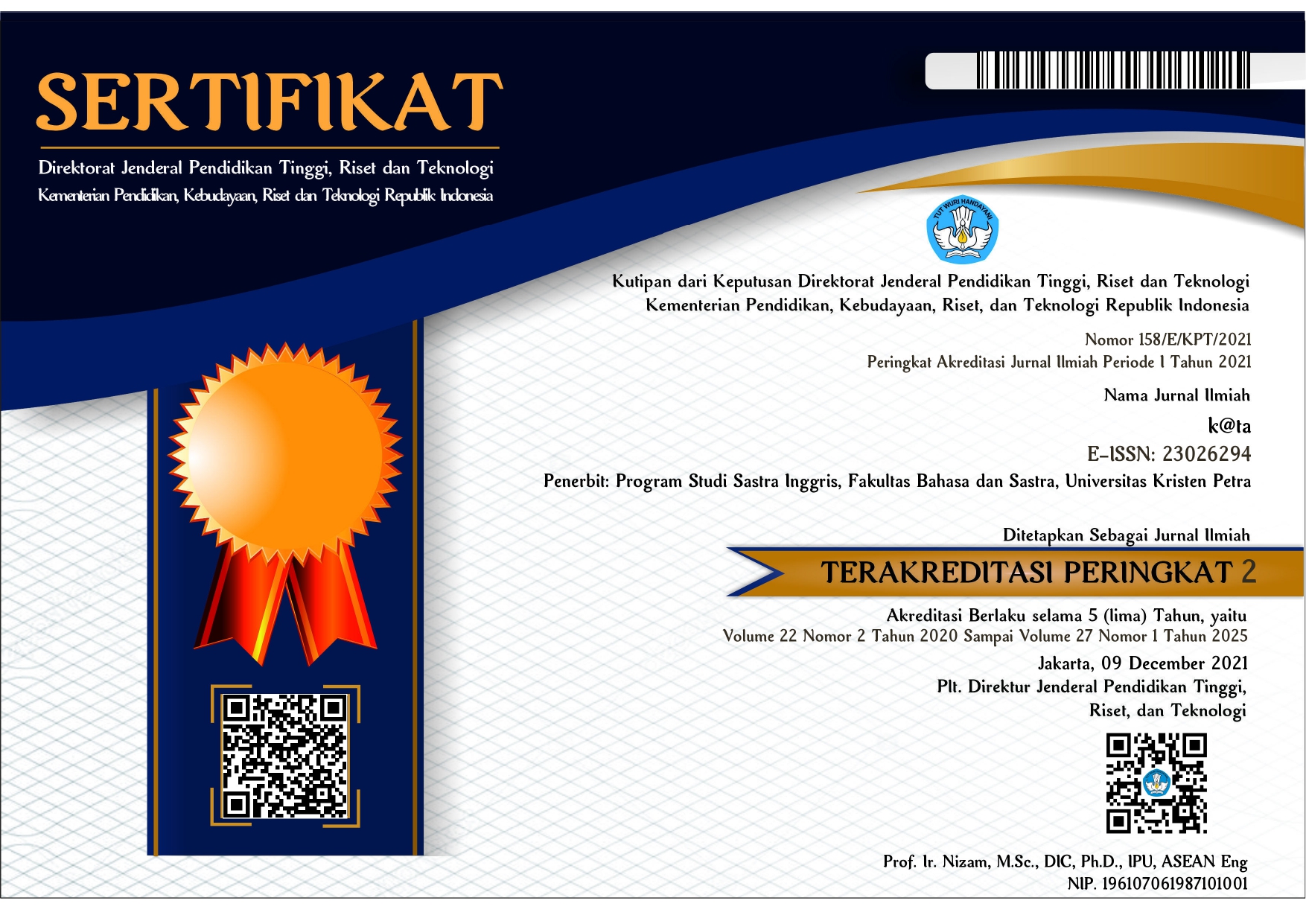"What is it else?" Love's (Con-)Text in Romeo and Juliet
Abstract
Reading Romeo and Juliet from Jacques Derrida's perspective provides us with new insight to Shakespeare's portrayal of love. As an early tragedy, Romeo and Juliet is a study of the nature of love. Many believe that the play still follows the lead of the comedies in presenting its major theme. However, drawing upon Derrida's deconstruction of the play, we have shown that love as an idea, a word, or a nomenclature, follows the same aporetic law of the proper name in that it is split, not unified, contradictory, not lucidly meaningful. We have demonstrated the multiplicity of love's identity despite the universally unifying attributes attached to it by the individual characters inside the play. In short, this reading reveals that identity in general, and the identity of love in particular, is not fixed, that they are products of textuality.
Downloads
References
Bate, J., & Rasmussen, E. (Eds.) (2007). William Shakespeare's complete works. Hampshire: Macmillan.
Bates, C. (2002). Shakespeare's tragedies of love. In C. McEachern (Ed.), The cambridge companion to Shakespearean tragedy (pp. 182-203). Cambridge: Cambridge University Press.
Belsey, C. (2002). Critical practice. London and New York: Routledge.
Bevington, D. (2002). Tragedy in Shakespeare's career. In C. McEachern (Ed.), The cambridge companion to Shakespearean tragedy (pp. 50-68). Cambridge: Cam¬bridge University Press.
Bloom, H. (1998). Shakespeare: The invention of the human. London: Fourth Estate Limited.
Booker, M. K. (1996). A practical introduction to literary theory and criticism. New York: Longman.
Brisman, L. (1975 Spring). At thy word: A reading of Romeo and Juliet. Bulletin of the Midwest MLA, 8 (1), 21-35.
Charlton, H. B. (1970). Shakespeare's experimental tragedy. In D. Cole (Ed.), Twentieth century interpretations of Romeo and Juliet: A collection of critical essays (pp. 49-60). New Jersey: Prentice-Hall, Inc.
Charney, M. (2000). Shakespeare on Love and Lust. New York: Columbia University Press.
Clemen, W. H (1970). Romeo and Juliet. In D. Cole (Ed.), Twentieth century interpretations of Romeo and Juliet: A collection of critical essays (pp. 66-75). New Jersey: Prentice-Hall, Inc.
Cobb, W. S., (Trans.). (1993). The symposium and the phaedrus: Plato's erotic dialogues. New York: State University of New York Press.
Culler, J. (1997). Literary theory: A very short introduction. Oxford: Oxford University Press.
Derrida, J. (1973). Speech and phenomena. (D. B. Allison, Trans.). Evanston, IL: Northwestern University Press.
Derrida, J. (1976). Of grammatology. (G. C. Spivak, Trans.). Baltimore, MD: John Hopkins Press.
Derrida, J. (1982a). The ear of the other: Otobiography, transference, translation. New York: Schocken Books.
Derrida, J. (1982b). Margins of philosophy. (A. Bass, Trans.). Chicago: The University Chicago.
Derrida, J. (1987). The post card: From Socrates to Freud and beyond. (A. Bass, Trans.). Chicago, IL: Chicago University Press.
Derrida, J. (1998). Monolingualism of the other; or, the prosthesis of origin. Stanford, California: Stanford University Press.
Derrida, J. (2008). Psyche: Inventions of the other. Vol. II. Stanford, California: Stanford University Press.
Derrida, J. (Speaker). (2011, Jan. 26). On love and being [Video file]. Retrieved from http://www.youtube.com/ watch?v=dj1BuNmhjAY
Dickey, F. M. (1966). Not wisely but too well: Shakespeare's love tragedies. San Marino, California: The Huntington Library.
Gibbons, B. (Ed.). (1980). Romeo and Juliet. (2nd series). London: Methuen. The Arden Shakespeare.
Harris, J. G. (2010). Shakespeare and literary theory. Oxford: Oxford University Press.
Kamuf, P. (2000). Deconstruction and love. In N. Royle (Ed.), Deconstructions: A user's guide (pp. 151-70). New York: Palgrave.
Lecht, J. (1990). Julia Kristeva. London and New York: Routledge.
Lewis, M. (2008). Derrida and Lacan: Another writing. Edinburgh: Edinburgh University Press.
McAlindon, T. (2002). What is a Shakespearean tragedy? In C. McEachern (Ed.), The cambridge companion to Shakespearean tragedy (pp. 1-22). Cambridge: Cambridge University Press.
Nordlund, M. (2007). Shakespeare and the nature of love: Literature, culture, evolution. Illinois: Northwestern University Press.
Oxford English Dictionary (2009). (2nd ed.). [CD-ROM]. Vol. 4.0.0.2. Oxford: Oxford University Press.
Ryan, K. (2002). Shakespeare. (3rd ed.). Hampshire and New York: Palgrave.
Snyder, S. (1979). The comic matrix of Shakespeare’s tragedies: “Romeo and Juliet”, “Hamlet”, “Othello” and “King Lear”. Princeton, New Jersey: Princeton University Press.
Spurgeon, F. E. (1970). Light images in Romeo and Juliet. In D. Cole (Ed.), Twentieth century interpretations of Romeo and Juliet: A collection of critical essays (pp. 61-65). New Jersey: Prentice-Hall, Inc.
Stocker, B. (2006). Routledge philosophy guidebook to Derrida on deconstruction. London and New York: Routledge.
The Bible: Authorized King James version (1997). With an introduction and notes by Robert Carroll and Stephen Prickett. Oxford: Oxford University Press.
Waller, G. (1991). Decentering the bard: The dissemination of the Shakespearean text. In D. Cole & David M. Bergeron (Eds.), Shakespeare and deconstruction (pp. 21-46). New York: Peter Lang.
White, R. S., (Ed.). (2001). Romeo and Juliet: New casebooks. Hampshire and New York: Palgrave.
Wolfreys, J. (1998). Deconstruction: Derrida. London: MacMillan Press Ltd.
This work is licensed under a Creative Commons Attribution License




















